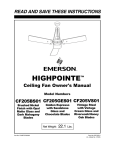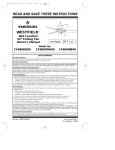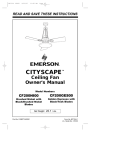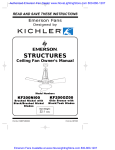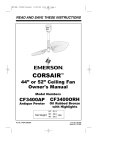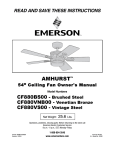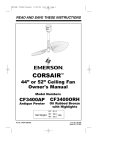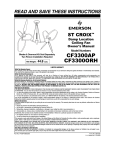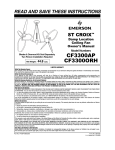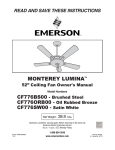Download Emerson CF945WB Owner`s manual
Transcript
READ AND SAVE THESE INSTRUCTIONS Model No. Net Weight: ® 33.0 Lbs. CF945WB 00 CF945HTW 00 CF945AB 00 CF945PW 00 CHATEAU ROYALE Series Ceiling Fan Owner's Manual LIMITED WARRANTY What The Warranty Covers: This warranty covers the motor and the other components and accessories of your Emerson ceiling fan against all defects in workmanship and materials. You must be the original purchaser or user of the product to be covered. What The Period Of Coverage Is: As it applies to the motor, this warranty will last for thirty years from the date you purchased your ceiling fan. All other components and accessories are covered by this warranty for one year from the date you purchased your ceiling fan. ANY IMPLIED WARRANTY OF MERCHANTABILITY OR FITNESS FOR A PARTICULAR PURPOSE, MADE WITH RESPECT TO COMPONENTS AND ACCESSORIES IS ALSO LIMITED TO ONE YEAR. What Will Emerson Company Do To Correct Problems: Emerson will replace a defective Emerson Air Comfort Ceiling Fan motor, blade, component or other accessory at no charge to you. If repair of the motor or blades is not practical or possible within a reasonable time and no replacement can be provided, Emerson will refund the actual purchase price of your fan. WE WILL SHIP THE REPAIRED PRODUCT OR REPLACEMENT TO YOU AT NO CHARGE, BUT YOU ARE RESPONSIBLE FOR ALL COSTS OF REMOVAL, REINSTALLATION AND SHIPPING OF THE PRODUCT TO EMERSON. How Can You Get Service: YOU MUST HAVE PROOF OF YOUR PURCHASE OF THE CEILING FAN TO OBTAIN LIMITED WARRANTY SERVICE. KEEP YOUR RECEIPT OR OTHER PROOF OF PURCHASE. You can return the product to our factory or to your nearest authorized service center. • To return the product to the factory, obtain a return authorization and service identification tag by writing to Air Comfort Products, Division of Emerson Company, 8100 W. Florissant Ave., St. Louis, MO 63136. Include all model numbers shown on the product with your request. • To return the product to an authorized service center, call 1-800-654-3545 for the address of the nearest authorized service center. You will be responsible for all insurance, freight or other transportation charges to our factory or authorized service center. Your Emerson Air Comfort Ceiling Fan should be properly packed to avoid damage in transit since we will not be responsible for any such damage. What Is Not Covered: The glass globes and light bulbs of your ceiling fan are not covered by this warranty. This warranty also does not cover any defects, malfunctions or failures caused by: • Repairs by persons not authorized by Emerson Company, • Use of parts or accessories not authorized by Emerson Company, • Mishandling, improper installation, modifications or damage to your ceiling fan while in your possession, or • Unreasonable use, misuse, abuse, including failing to do reasonable and necessary maintenance, and normal wear and tear. Additionally, this warranty and any implied warranty of merchantability or fitness for a particular purpose are voided when: • The original purchaser or user ceases to own the product, or • The fan is moved from its original point of installation. This warranty is only valid within the 50 states of the United States and the District of Columbia. No other written or oral warranties apply, and no employee, agent, dealer or other person is authorized to give any warranties on behalf of Emerson Company. REPAIR, REPLACEMENT OR A REFUND ARE THE EXCLUSIVE REMEDIES AVAILABLE UNDER THIS WARRANTY AND EMERSON IS NOT RESPONSIBLE FOR DAMAGES OF ANY KIND, INCLUDING INCIDENTAL AND CONSEQUENTIAL DAMAGES. Incidental damages include but are not limited to such damages as loss of time and loss of use. Consequential damages include but are not limited to the cost of repairing or replacing other property which was damaged if this product does not work properly. How State Law Relates To The Warranty: Some states do not allow the exclusion or limitation of incidental or consequential damages so the above exclusion or limitation may not apply to you. This warranty gives you specific legal rights, and you may also have other rights which vary from state to state. Part No. F40BP72650000 Form No. BP7265 ! WARNING WARNING: To avoid fire, shock, and serious personal injury, follow these instructions. Safety Instructions 1. Read your owner’s manual carefully and keep it for future reference. 2. Before servicing or cleaning unit, switch power off at service panel and lock service panel disconnecting means to prevent power from being switched on accidentally. When the service disconnecting means cannot be locked, securely fasten a warning device, such as a tag, to the service panel. 3. Be careful of the fan and blades when cleaning, painting, or working near the fan. Always turn off the power to the ceiling fan before servicing. 4. Do not put anything into the fan blades while they are turning. 5. Do not operate reversing switch until fan blades have come to a complete stop. Additional Safety Instructions for Installation 1. To avoid possible shock, be sure electricity is turned off at the fuse box before wiring, and do not operate fan without blades. 2. All wiring must satisfy National and Local Electrical Codes. Use the National Electrical Code if Local Codes do not exist. The ceiling fan must be grounded as a precaution against possible electrical shock. Electrical installation should be made or approved by a licensed electrician. 3. The outlet box and joist must be securely mounted and capable of reliably supporting at least 50 pounds. Use only U.L. outlet boxes listed as acceptable for fan support, and use the mounting screws provided with the outlet box. Most outlet boxes commonly used for support of light fixtures are not acceptable for fan support and may need to be replaced. Consult a qualified electrician if in doubt. 4. The 4-1/2” downrod furnished with the fan provides the minimum recommended floor to fan blade clearance for an 8 foot ceiling. The 18” downrod furnished with the fan must be used with a 9 foot (minimum) ceiling or a cathedral ceiling. The 18” downrod must be installed when using the decorative rods. 5. The fan must be mounted with the fan blades at least 7 feet from the floor to prevent accidental contact with the fan blades. 6. Follow the recommended instructions for the proper method of wiring your ceiling fan. If you do not know enough about electrical wiring, have your fan installed by a licensed electrician. WARNING: To avoid fire, shock or injury, do not use an Emerson or any other brand of control not specifically approved for this fan. WARNING: This product is designed to use only those parts supplied with this product and/or any accessories designated specifically for use with this product by Emerson. Substitution of parts or accessories not designated for use with this product by Emerson could result in personal injury or property damage. WARNING: To reduce the risk of personal injury, do not bend the blade flange when installing the blade flanges, balancing the blades or cleaning the fan. Do not insert foreign objects in between rotating fan blades. DATE CODE: The date code of this fan may be found on the box, stamped in ink on a white label. You should record this data above and keep it in a safe place for future use. 2 This Manual Is Designed to Make it as Easy as Possible for You to Assemble, Install, Operate and Maintain Your Ceiling Fan Tools Needed for Assembly One Phillips head screwdriver One stepladder One 1/4” blade screwdriver One wire stripper Three wire connectors (supplied) MATERIALS 1. Wiring outlet box and box connectors must be of type required by the local code. The minimum wire would be a 3-conductor (2-wire with ground) of the following size: Installed Wire Length Wire Size A.W.G. Up to 50 ft. 14 50-100 ft. 12 2. A 9-volt alkaline battery is required for operating the remote control. 3. Four 40-watt (maximum) candelabra base lamps are required for the uplights. ! WARNING Before assembly your ceiling fan, refer to instructions on proper method of wiring your fan (page 6). If you feel you do not have enough wiring knowledge or experience, have your fan installed by a licensed electrician. Unpacking Instructions For your convenience, check-off boxes are provided next to each step. As each step is completed, place a check mark in the box. This will insure that all steps have been completed and will be helpful in finding your place should you be interrupted. ! WARNING Do not install or use fan if any part is damaged or missing. Call Toll-Free: 1-800-654-3545 ! WARNING This product is designed to use only those parts supplied with this product and/or any accessories designated specifically for use with this product by Emerson Company. Substitution of parts or accessories not designated for use with this product by Emerson Company could result in personal injury or property damage. 1. Check to see that you have received the following parts: NOTE: If you are uncertain of part description, refer to exploded view illustration. a. Fan motor assembly b. One switch housing c. Five fan blades d. One ceiling cover e. Five blade flanges f. One remote control transmitter g. One remote control receiver h. One hanger ball/downrod assembly i. One hanger bracket j. One coupling cover k. Three rod assemblies l. One rod support assembly m.One 18” downrod n. One loose parts bag containing: 1. Sixteen 3/16-24 x 3/8” slotted washer head blade screws 2. Sixteen plastic washers 3. Eleven 1/4-20 x 1/2” flange screws 4. Three wire connectors 5. Two threaded studs 6. Two knurled knobs 7. Two lockwashers 3 8. One clevis pin 9. One hairpin clip 10. One 5/64” hex wrench NOTE: Place the parts from the loose parts bags in a small container to keep them from being lost. If any parts are missing, contact your local retailer or catalog outlet for replacement before proceeding. 2. Remove the fan motor assembly from the protective plastic bag and place it into the lower foam pad with the top of the fan motor assembly facing up. The lower foam pad serves as a holder for the fan during assembly. FAN MOTOR ASSEMBLY HANGER BALL/ DOWNROD ASSEMBLY LOOSE PARTS BAG BLADE FLANGES ROD SUPPORT ASSEMBLY REMOTE CONTROL TRANSMITTER COUPLING COVER HANGER BRACKET CEILING COVER SWITCH HOUSING REMOTE CONTROL RECEIVER 18" DOWNROD ROD ASSEMBLY (3) FAN BLADES Electrical Requirements lights on and off and control the light intensities. The red indicator light will illuminate while any button is pressed, indicating that the battery is good. Your new ceiling fan will require a grounded electrical supply line of 120 volts AC, 60 Hz, 15 amp circuit. The remote control transmitter is powered by a 9-volt alkaline battery (not included). To prevent possible damage if the battery should leak, be sure to remove the battery when the control is not to be used for an extended period of time. The outlet box must be securely anchored and capable of withstanding a load of at least 50 pounds. ! Code switches in the transmitter and receiver may be set in 16 different positions. If your fan and light go on and off without using your control, you may be getting interference from other remote units such as garage door openers, car alarms or security systems. To remedy this situation, simply change the combination code in your transmitter and receiver. WARNING To reduce the risk of fire, electric shock, or personal injury, mount fan to outlet box marked acceptable for fan support, and use screws supplied with outlet box. Most outlet boxes commonly used for support of light fixtures are not acceptable for fan support and may need to be replaced. Consult a qualified electrician if in doubt. Preset Memory Feature If your fan is to replace an existing ceiling light fixture, turn electricity off at the main fuse box at this time and remove the existing light fixture. ! Your Emerson remote control receiver is equipped with a preset memory feature. If the electrical supply to the receiver is controlled through a wall switch, when the switch is turned off, the control will remember the light intensities and fan speed. When the switch is turned back on, the lights and fan will resume operation as they were prior to the switch being turned off. WARNING Turning off wall switch is not sufficient. To avoid possible electrical shock, be sure electricity is turned off at the main fuse box before wiring. All wiring must be in accordance with National and Local codes and the ceiling fan must be properly grounded as a precaution against possible electrical shock. ! Installation of Battery 1. Remove the battery cover by pressing firmly below the arrow and sliding the cover off the control (Figure 1). 2. Remove the connector from the battery compartment and attach it to the 9-volt alkaline battery (not included). WARNING To avoid fire or shock, follow all wiring instructions carefully. Any electrical work not described in these instructions should be done or approved by a licensed electrician. CODE SWITCH IMPORTANT This Owner’s Manual is divided into two sections. The first section, REMOTE CONTROL PROCEDURES, describes how to install the 9-volt alkaline battery (not included) in the remote control transmitter, and how to set the operating frequency of the transmitter and receiver. These instructions must be performed prior to installation of the ceiling fan as described in the second section, CEILING FAN PROCEDURES. SWITCH LEVERS 1 2 3 4 ON 1 2 3 4 CODE SWITCH REMOTE CONTROL RECEIVER ON REMOTE CONTROL TRANSMITTER REMOTE CONTROL PROCEDURES BATTERY CONNECTOR General The remote control supplied with your Emerson ceiling fan consists of a hand-held transmitter and a receiver which is mounted in the switch housing. The remote control is designed to separately control your ceiling fan and light intensities. There are four push buttons (HI, MED, LOW, OFF) to set the fan speed and turn the fan off. The REV push button changes the airflow direction of the fan blades. The U/L (uplight) and D/L (downlight) pushbuttons turn the CODE SWITCH Figure 1 4 BATTERY BATTERY COVER Setting Operating Frequency of Transmitter and Receiver NOTE: The setscrews must be properly installed as described above, or fan wobble could result. Your remote control transmitter and receiver have code switches which must be set on one of 16 possible code combinations. The four levers (numbered 1, 2, 3, and 4) on the switches are factoryset in the ON (up) position. Do not use this setting. Change the switch settings as follows: 1. Slide the four switch levers (Figure 1) in the remote control transmitter to your choice of ON (up) or down positions. Use a ball-point pen or small screwdriver and slide the levers firmly up or down. 2. In the receiver, slide the four switch levers in the same positions as set in the transmitter. Make sure the levers on both switches are in the same positions; otherwise the fan will not operate. 3. Position the battery in the transmitter battery compartment and replace the battery cover. It is critical that the clevis pin in the motor coupling is properly installed and the setscrews securely tightened. Failure to verify that the pin and setscrews are properly installed could result in the fan falling. ! WARNING DOWNROD HAIRPIN CLIP CLEVIS PIN UPPER SETSCREW (2) LOWER SETSCREW (2) CEILING FAN PROCEDURES MOTOR COUPLING Figure 3 3. Make sure the grommet is properly installed in the coupling cover, then slide the coupling cover on the downrod until it rests on the motor housing (Figure 4). How to Put Your Ceiling Fan Together 1. Remove the hanger ball by loosening the setscrew in the hanger ball until the ball falls freely down the downrod (Figure 2). Remove the pin from the downrod, then remove the hanger ball. Retain the pin and hanger ball for reinstallation in Step 5. DOWNROD COUPLING COVER PIN HANGER BALL SETSCREW DOWNROD Figure 4 Figure 2 IMPORTANT 2. Separate, untwist and unkink the two 80” motor leads. Route the motor lead wires through either the 4-1/2” or the 18” downrod. Remove the two upper setscrews from the motor coupling. Align the clevis pin holes in the downrod with the holes in the motor coupling. Install the clevis pin and secure with the hairpin clip (Figure 3). The clevis pin must go through the holes in the motor coupling and the holes in the downrod. Be sure to push the straight leg of the hairpin clip through the hole near the end of the clevis pin until the curved portion of the hairpin clip snaps around the clevis pin. The hairpin clip must be properly installed to prevent the clevis pin from working loose. Pull on the downrod to make sure the clevis pin is properly installed. Reinstall the upper setscrews in the motor coupling. Check that the lower setscrews are tightened securely (Figure 3). A. If you have installed an 18” or longer downrod and are planning to install the decorative support rods assembly, proceed to “INSTALLATION OF DECORATIVE SUPPORT RODS ASSEMBLY” on page 9. After you have installed the decorative support rods assembly, continue with the following installation procedures. B. If you have installed the 4-1/2” downrod, continue now with the following procedures. 4. Position the ceiling cover over the downrod. Be sure the cover is oriented correctly, with the large opening at the top (Figure 5). 5 CEILING PIN HANGER BALL SETSCREW AT LEAST 7' DOWNROD CEILING COVER FLOOR Figure 7 Figure 5 ! 5. Reinstall the hanger ball (Figure 5) on the downrod as follows. Route the two 80” motor leads through the hanger ball. Position the pin through the two holes in the downrod and align the hanger ball so the pin is captured in the groove in the top of the hanger ball. Pull the hanger ball up tight against the pin. Securely The outlet box must be securely anchored and capable of withstanding a load of at least 50 lbs. ! tighten the setscrew in the hanger ball. A loose setscrew could create fan wobble. ! WARNING WARNING To reduce the risk of fire, electric shock, or personal injury, mount fan to outlet box marked acceptable for fan support, and use screws supplied with outlet box. Most outlet boxes commonly used for support of light fixtures are not acceptable for fan support and may need to be replaced. Consult a qualified electrician in in doubt. WARNING It is critical that the pin in the hanger ball is properly installed and the setscrew securely tightened. Failure to verify that the pin and setscrew are properly installed could result in the fan falling. 8.Securely attach the hanger bracket to the outlet box using the two screws supplied with the outlet box. (Figure 8.) 6.Screw in four 40-watt (maximum) candelabra base lamps in the housing sockets (Figure 6). Grasp the sockets and pivot them until the lamp bulbs are even with the outer edge of the housing as shown. This will provide the optimum lighting effect. ! WARNING Hanger bracket must seat firmly against outlet box. If the outlet box is recessed, remove wall board until bracket contacts box. If bracket and/or outlet box are not securely attached, the fan could wobble or fall. OUTLET BOX TOP ALIGN WITH OUTER EDGE OF THE HOUSING TWO SCREWS SUPPLIED WITH OUTLET BOX HANGER BRACKET SOCKET TAB Figure 8 2 Figure 9. Carefully lift the fan and seat the hanger ball/downrod assembly on the hanger bracket that was just attached to the outlet box (Figure 9). Be sure the groove in the ball is lined up with tab on the hanger bracket (Figure 8). CANDELABRA BASE LAMP Figure 6 7.The fan comes with black and white leads that are 80” long. Before installing fan, measure up approximately 6 to 9-inches above top of hanger ball/downrod assembly. Cut off excess leads and strip back insulation 1/2-inch from end of leads. ! ! WARNING Failure to seat tab in groove could cause damage to electrical wires and possible shock or fire hazard. WARNING The fan must be hung with at least 7' of clearance from floor to blades (Figure 7). ! 6 WARNING To avoid possible fire or shock, do not pinch wires between the hanger ball/downrod assembly and hanger bracket. NOTE: CEILING COVER, SUPPLY WIRES AND FAN WIRES OMITTED FOR CLARITY. 12. Screw the two threaded studs (supplied) into the tapped holes in the hanger bracket (Figure 10). OUTLET BOX 13. Lift the ceiling cover up to the threaded studs and turn until studs protrude through the holes in the ceiling cover (Figure 11). 14. Secure the ceiling cover in place by sliding lockwashers over the threaded studs and installing the two knurled knobs (supplied) (Figure 11). Tighten the knurled knobs securely until the ceiling cover fits snugly against the ceiling. HANGER BRACKET Figure 9 HANGER BALL/ DOWNROD ASSEMBLY If you feel that you do not have enough electrical wiring knowledge or experience, have your fan installed by a licensed electrician. ! CEILING COVER WARNING To avoid possible electrical shock, be sure electricity is turned off at the main fuse box before wiring. NOTE: If you are not sure if the outlet box is grounded, contact a licensed electrician for advice, as it must be grounded for safe operation. KNURLED KNOB Figure 11 10. Connect the green grounding lead from the hanger ball and the green grounding lead from the hanger bracket to the grounding conductor of supply (this may be a bare wire or wire with green colored insulation). Securely connect wires with wire connector supplied. (Figure 10). ! 15. Mount blade flanges to fan blades using three 3/16-24 x 3/8” slotted washer head blade screws, three plastic washers (Figure 12). 3/16-24 X 3/8" WASHER HEAD BLADE SCREW (3) WHITE SUPPLY (NEUTRAL) BLACK SUPPLY (HOT) PLASTIC WASHER (3) WHITE FAN WIRE SUPPLY GROUND WIRE WARNING To avoid possible fire or shock, make sure that the electrical wires are completely inside the outlet box and not pinched between the ceiling cover and the ceiling. 11. Securely connect the fan motor white wire to the supply white (neutral) wire using wire connector supplied (Figure 10). Securely connect the fan motor black wire to the supply black (hot) wire using wire connector supplied (Figure 10). After connections have been made, turn leads upward and carefully push leads into the outlet box. BLACK FAN WIRE LOCKWASHERS (2) THREADED STUD FAN BLADE HANGER BRACKET GREEN WIRE (GROUND) FROM HANGERBALL THREADED STUD (2) GREEN WIRE (GROUND) FROM HANGER BRACKET BLADE FLANGE LISTED WIRE CONNECTOR (3) Figure 12 NOTE: Take care not to scratch fan housing when installing blades. NOTE: Remove and discard the four shipping spacers and screws from the motor hub. Figure 10 ! WARNING Check to see that all connections are tight, including ground, and that no bare wire is visible at the wire connectors, except for the ground wire. Do not operate fan until blades are in place. Noise and fan damage could result. 7 16. Rotate the motor hub until the flange screw holes are visible through the slots in the switch housing plate. Loosely attach one blade assembly to the motor hub using two 1/4-20 x 1/2” flange screws (Figure 13). Make sure the screws are NOT tightened. Repeat this procedure for the other four blade assemblies. ! 19. Remove one of the mounting screws from the switch housing plate (Figure 14) and loosen the other two screws several turns. NOTE: If you are installing an Emerson Light Fixture with your fan, refer to the Light Fixture Owner’s Manual and proceed as follows. Remove the center screw from the switch housing and install the light fitter in the threaded hole. Connect the blue wire from the light fitter to the receiver blue wire, and the white wire from the light fitter to the receiver white wire. WARNING To reduce the risk of personal injury, do not bend the blade flange when installing the blade flanges, balancing the blades or cleaning the fan. Do not insert foreign objects in between rotating fan blades. 1/4-20 x 1/2" FLANGE SCREWS (INSTALL THROUGH SLOTS IN SWITCH HOUSING PLATE) 20. Remove the protective paper from the three adhesive blocks in the switch housing.Then position the remote control receiver securely onto the three adhesive blocks, making sure the antenna wire is uncoiled in the switch housing. 21. Engage the two slots in the switch housing with the two loosened mounting screws in the switch housing plate (Figure 15). Rotate the switch housing to the right, then tighten the two mounting screws and install the other mounting screw previously removed in Step 19. MOTOR HUB BLADE FLANGE MOUNTING SCREW (3) SWITCH HOUSING PLATE Figure 13 SWITCH HOUSING 17. The blade flanges have an interlocking feature that must be fully engaged before tightening the screws. Make sure all the flanges are properly engaged and then tighten the flange screws. If one of the flanges does not seat properly on the motor hub, loosen the adjacent flange screws, re-engage and reseat the flanges, then tighten the screws again. CENTER SCREW Figure 15 18. Engage the motor connector with the connector in the remote control receiver (Figure 14). The two connectors are keyed and must be mated correctly before they can be engaged. MOUNTING SCREW (3) SWITCH HOUSING PLATE MOTOR CONNECTOR RECEIVER CONNECTOR Figure 14 REMOTE CONTROL RECEIVER 8 Installation of the Decorative Support Rods Assembly NOTE: The following procedures are to be performed only if you have installed the 18” (or longer) downrod. 4. Raise the rod support assembly and loosely engage the rod ring with one of the hooks on the rod support assembly (Figure 18). Then tighten the setscrew using the 5/64” hex wrench (supplied). 1. Loosen the setscrew in the collar of the rod support assembly using the 5/64” hex wrench (supplied) and slide the support assembly over the downrod (Figure 16). ROD SUPPORT ASSEMBLY HOOK SETSCREW ROD SUPPORT ASSEMBLY SETSCREW DOWNROD ROD ASSEMBLY LOOSELY ENGAGE ROD RING WITH HOOK Figure 18 5. Engage the other two support rods in the same manner as above. Loosen the setscrew and raise the rod support assembly until the support rods are taut and in line with the downrod (Figure 19). Then securely tighten the setscrew using the 5/64” hex wrench. Figure 16 2. Verify that one or two threads are visible between the decorative turnbuckle and the rod segments (Figure 17). If necessary, turn rod segments to expose more threads. Repeat for all rod assemblies. 6. Tighten (rotate) the turnbuckles (Figure 17) of the rod assemblies to take up any slack, thereby reducing the chance of noise due to vibration when the fan is operating. 3. Engage the rod hook with the ring in the housing assembly (Figure 17). NOTE: The decorative support rods are now installed and the fan is ready for further installation. Continue with Step 4 in CEILING FAN PROCEDURES, Page 5. ROD SEGMENT DECORATIVE TURNBUCKLE (ROTATE THE TURNBUCKLE TO REMOVE SLACK IN ROD ASSEMBLY; SEE STEP 6) HOUSING ASSEMBLY SETSCREW HOOK RING Figure 17 DOWNROD 9 Figure 19 SUPPORT RODS SHOULD BE IN LINE WITH DOWNROD Operation Installation of Storage Bracket IMPORTANT Fan installation must be completed, including the installation of the fan blades, before testing of the remote control. Your remote control has full control of your fan and lights. NOTE: Prior to operation of the down light from the remote control, make sure the switch on the light is ON. 1. To set the desired fan speed, press the HI, MED, or LOW button to operate your fan on high, medium, or low speed. 2. To turn your fan off, press the OFF button. 3. To change the airflow direction of the fan blades, press the REV button. 4. To turn the downlight on, press and release the D/L button. The light will turn on at the light intensity previously selected. 5. To turn the uplight on, press and release the U/L button. The light will turn on at the light intensity previously selected. 6. To vary the intensity of the light, hold the U/L or D/L button down until the desired light intensity is reached, then release the button. A storage bracket is supplied with the remote control for holding the control unit when not in use. If you desire to use the bracket, use the two screws (supplied) and install it on a wall that is away from excess heat or humidity. Maintenance IMPORTANT CARE INSTRUCTIONS for your Ceiling Fan Periodic cleaning of your new ceiling fan is the only maintenance that is needed. When cleaning, use only a soft brush or lint free cloth to avoid scratching the finish. Abrasive cleaning agents are not required and should be avoided to prevent damage to finish. ! WARNING Do not use water when cleaning your ceiling fan. It could damage the motor or the blades and create the possibility of an electrical shock. Accessories 1. Ceiling Fan Light Kits (see store or catalog). 2. Downrod Extension Kits (see store or catalog). MED U L LOW HI ! REV OFF D WARNING The use of any other control not specifically approved for this fan could result in fire, shock and personal injury. L ! WARNING This product is designed to use only those parts supplied with this product and/or any accessories designated specifically for use with this product by Emerson Company. Substitution of parts or accessories not designated for use with this product by Emerson Company could result in personal injury or property damage. STORAGE BRACKET ® 10 ! WARNING: For your own safety, turn off power at fuse box or circuit breaker before trouble shooting your fan. Trouble Shooting TROUBLE 1. Fan will not start. 2. Fan sounds noisy. PROBABLE CAUSE SUGGESTED REMEDY 1. Fuse or circuit breaker blown. 1. Check main and branch circuit fuses or circuit breakers. 2. Loose power line connections to the fan in the ceiling cover. 2. Check line wire connections to fan in the ceiling cover. ! WARNING: Make sure main power is turned OFF. 3. Dead battery in Remote Control transmitter. 3. Replace battery (red indicator light on transmitter should light when any button is pressed). 4. Code switches in Remote Control receiver and transmitter are not in same positions. 4. Check that code switches are in same positions. Reset if necessary. 1. Blades not attached to fan. 1. Attach blades to fan before operating. 2. Loose screws in motor housing. 2. Check to make sure all screws in motor housing are snug (not over-tight). 3. Screws securing fan blade flanges to motor are loose. 3. Check to make sure the screws which attach the fan blade flanges to the motor are tight. 4. Wire connectors inside the switch housing are rattling. 4. Check to make sure wire connectors in the switch housing are not rattling against each other or against the interior wall of the switch housing. ! 3. Fan wobbles excessively. 4. Short range for Remote Control. WARNING: Make sure main power is turned OFF. 5. Screws holding blades to flanges are loose. 5. Tighten screws securely. 1. Setscrews in motor coupling are loose. 1. Tighten setscrews securely in the motor coupling. 2. Setscrew in hanger ball/downrod assembly is loose. 2. Tighten the setscrew in the hanger ball/ downrod assembly. 3. Screws securing fan blade flanges to motor are loose. 3. Check to be sure screws which attach the fan blade flanges to the motor are tight. 4. Fan blade flanges not seated properly. 4. Check to be sure the fan blade flanges seat firmly and uniformly to the surface of the motor. If flanges are seated incorrectly, loosen the flange screws and retighten according to the procedure in the section on "CEILING FAN PROCEDURES". 5. Hanger bracket and/or ceiling outlet box is not securely fastened. 5. Tighten the hanger bracket screws to the outlet box, and/or secure outlet box. 6. Fan blades out of balance. 6. Interchanging an adjacent (side-by-side) blade pair can redistribute the weight and result in smoother operation. 1. The Remote Control operates the fan when close in, but does not operate at a distance of 30 feet. 1. Try placing the antenna wire outside the switch housing. 2. Try a different frequency setting on the transmitter/receiver (both MUST be set the same). 11 Repair Parts Model No. Key No. Description 2 CF945WB00 CF945HTW00 CF945AB00 CF945PW00 Hanger Ball Assembly, Consisting of: 1 Hanger Bracket 761655-20 761655-12 — — — — — — — — — — — 762292 762292-1 762292 762292 4 Wire Connector (3) — — — — 5 Wrench, Hex , 5/64 — — — — 6 Threaded Stud (2) — — — — 7 Lockwasher (2) — — — — 8 Knurled Knob (2) — — — — 9 Pin, Clevis — — — — 10 Clip, Hairpin — — — — 11 Screw, 1/4-20 x 1/2” (11) — — — — 12 Screw, 3/16-24 x 3/8” (16) — — — — 13 Washer, Plastic (16) — — — — 14 Screw, 5/32-32 x 3/8” (3) — — — — 15 Ceiling Cover 761939-3 761939-1 761939-6 761939-7 16 Coupling Cover 761860-6 761860-5 761860-7 761860-12 17 Remote Control Transmitter 762281 762281 762281 762281 18 Switch Housing 762257 762257-1 762257-2 762257-3 19 Flange (Set of 5) 762288 762288-1 762288-2 762288-3 20 Blade (Set of 5) 761859-24 761859-6 761859-8 761859-17 762291 762291 22 Downrod, 18” 3 6 — 2 Hanger Ball 21 Remote Control Receiver 1 761655-3 761655-22 3 Downrod Parts Bag Containing: 4 5 762291 15 24 22 16 23 762290-1 762290-2 762290-3 24 Rod Support Assembly 762289 762289-1 762289-2 762289-3 — Owner's Manual BP7265 BP7265 BP7265 BP7265 Before discarding packaging material, be certain all parts have been removed. 21 12 13 760239-146 760239-183 760239-40 760239-161 762290 9 17 762291 23 Rod Assembly (3) 7 8 10 18 14 20 HOW TO ORDER REPAIR PARTS WHEN ORDERING REPAIR PARTS, ALWAYS GIVE THE FOLLOWING INFORMATION: • PART NUMBER • NAME OF ITEM 19 11 • PART DESCRIPTION • MODEL NUMBER For repair parts, phone 1-800-654-3545. EMERSON Air Comfort Products DIVISION OF EMERSON COMPANY 8100 W. Florissant, St. Louis, MO 63136 Part No. F40BP72650000 Printed in Taiwan 03/02 Form No. BP7265












